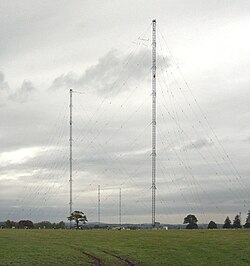Droitwich Transmitting Station
 Masts at the Droitwich transmitting station | |
| Location | Droitwich, Worcestershire |
|---|---|
| Mast height | 213.36 metres (700 ft) |
| Coordinates | 52°17′48″N 2°06′19″W / 52.296666666667°N 2.1052777777778°W |
| Grid reference | SO929663 |
| Built | 1934 |
The Droitwich transmitting station is a large broadcasting facility for long-wave and medium-wave transmissions, established in 1934 in the civil parish of Dodderhill, just outside the village of Wychbold, near Droitwich in Worcestershire, England (grid reference SO929663). The site is the location of the British Broadcasting Corporation's most powerful long-wave transmitter, which together with the two Scottish long-wave transmitters at Burghead and Westerglen forms a network broadcasting on the same frequency. The masts can be seen to the east from the M5 motorway, between Droitwich and Bromsgrove, as well as to the west from the Herefordshire/Worcestershire border. At night, the two sets of aircraft warning lights are visible from a long distance. Due to the bright red lights illuminated at night, some locals have renamed the site "the devil horns of Wychbold". The station is owned and operated by Arqiva.
Technical specifications
The long-wave frequency used was 200 kilohertz (frequently referred to by the wavelength, 1,500 metres) until 1 February 1988[1] when it was changed to 198 kilohertz, and the power is currently 500 kilowatts. The carrier frequency is controlled by a rubidium atomic frequency standard in the transmitter building, enabling the transmission to be used as an off-air frequency standard. For long-wave, a T-aerial is used, which is suspended between two 213-metre-high (700 ft) guyed steel lattice radio masts, which stand 180 metres (590 ft) apart from each other. There are also two guyed mast radiators at the site. The northerly mast is actually the transmitting antenna whilst the southern mast is a passive reflector causing the rf signal to form a cardioid pattern tending in a NE direction so as not to interfere with the similar set up in Bristol. The smaller mast system transmits digital radio signals. The main large system is used for transmitting AM medium-wave radio programmes on 693 kilohertz, 1053 kilohertz and 1215 kilohertz.
Transmissions
BBC Radio 4 Longwave is transmitted on 198 kHz. This signal also carries radio data encoded using phase modulation, giving a time-of-day signal, and radio teleswitch control signals for Economy 7 electric-heating systems.
BBC Radio 5 Live is broadcast on 693 kHz medium wave (MW), providing coverage for most of the English Midlands and Wales at a signal strength (150 kW) which is one of the strongest for that station, equal to Brookmans Park and second only to Moorside Edge.
During World War II coded messages, read during normal programme broadcasts, were sent to the French Resistance using the transmitter.[2]
In 2011, as a result of budget cuts, the BBC announced that there would be no re-investment in long wave transmissions, which may mean an eventual end to BBC Radio 4 Longwave broadcasts.[3] The same year, The Guardian reported that the transmitter relies upon a pair of glass valves, of which there are fewer than 10 left in the world, and the BBC did not believe it was safe enough to manufacture more, because "slightly faulty" replacements could cause catastrophic failure.[4]
Reception
The Radio 4 LW signal from Droitwich covers most of England and Wales. There are supplementary long-wave transmitters in Scotland (Burghead and Westerglen, both 50 kW), with medium-wave transmitters in various parts of England, Scotland and Northern Ireland. The station can also be heard clearly in most of the Republic of Ireland, particularly along eastern and southern counties. Reception is also possible in Western Europe, including Italy and Sweden.
Services available
| Frequency | kW | Service |
|---|---|---|
| 198 kHz | 500 | BBC Radio 4 |
| 693 kHz | 150 | BBC Radio 5 Live |
| 1053 kHz | 500 | Talksport |
Formerly:
| Frequency | kW | Service | Ceased |
|---|---|---|---|
| 1215 kHz | 200 | Absolute Radio | January 20, 2023[5] |
See also
- List of masts
- List of radio stations in the United Kingdom
- List of tallest buildings and structures in Great Britain
- Radio teleswitch
References
- ^ "BBCEng.Info - Droitwich Calling". Retrieved 31 January 2012.
- ^ "Droitwich calling". BBC Hereford & Worcester. 4 December 2007. Retrieved 22 September 2023.
- ^ "BBC set to cut 2,000 jobs by 2017". BBC News. 6 October 2011. Retrieved 22 September 2023.
- ^ "Radio 4's long wave goodbye". The Guardian. 9 October 2011. Retrieved 22 September 2023.
- ^ "Absolute Radio to switch off all AM transmitters across the UK". 4 January 2023.

